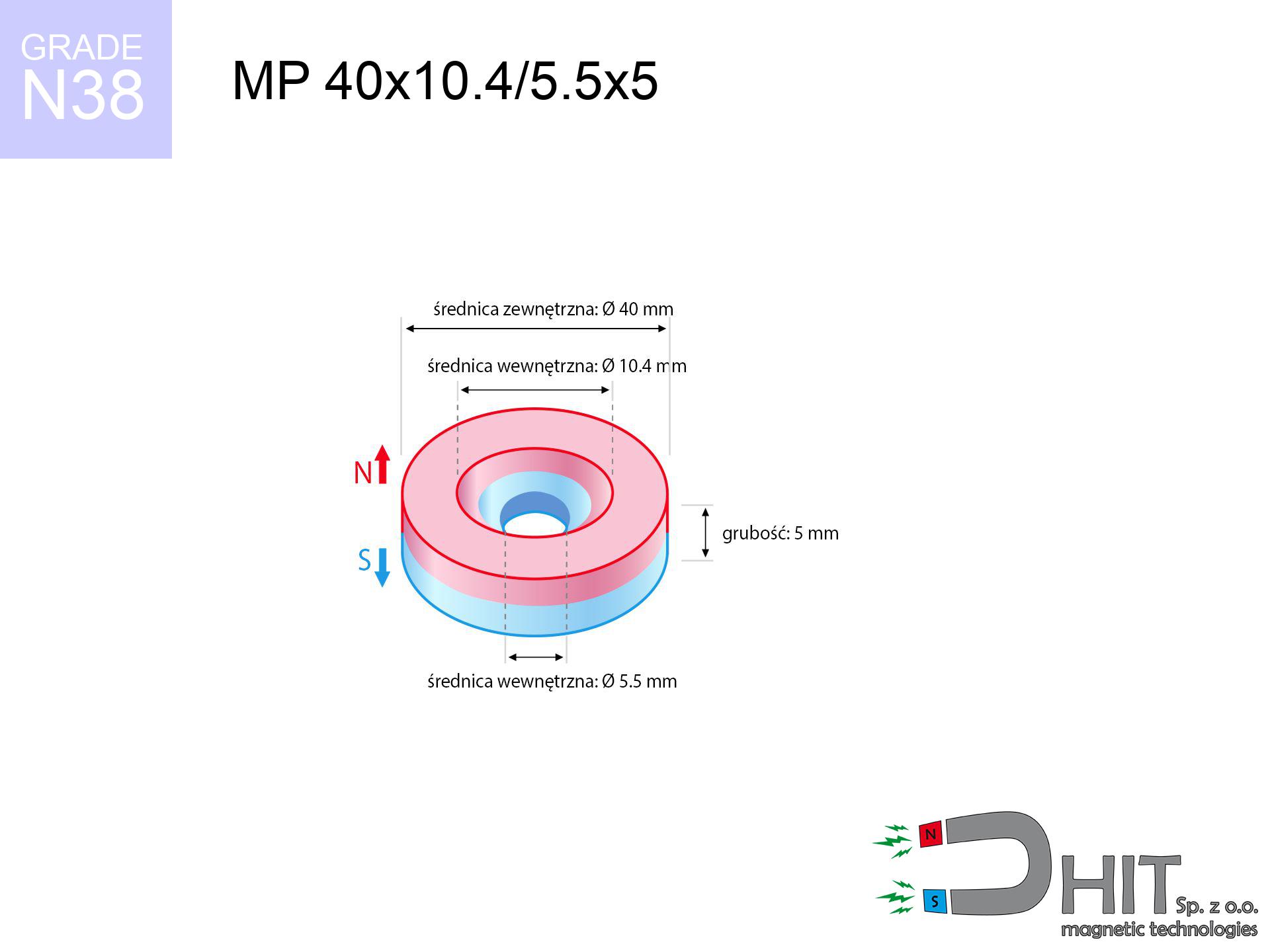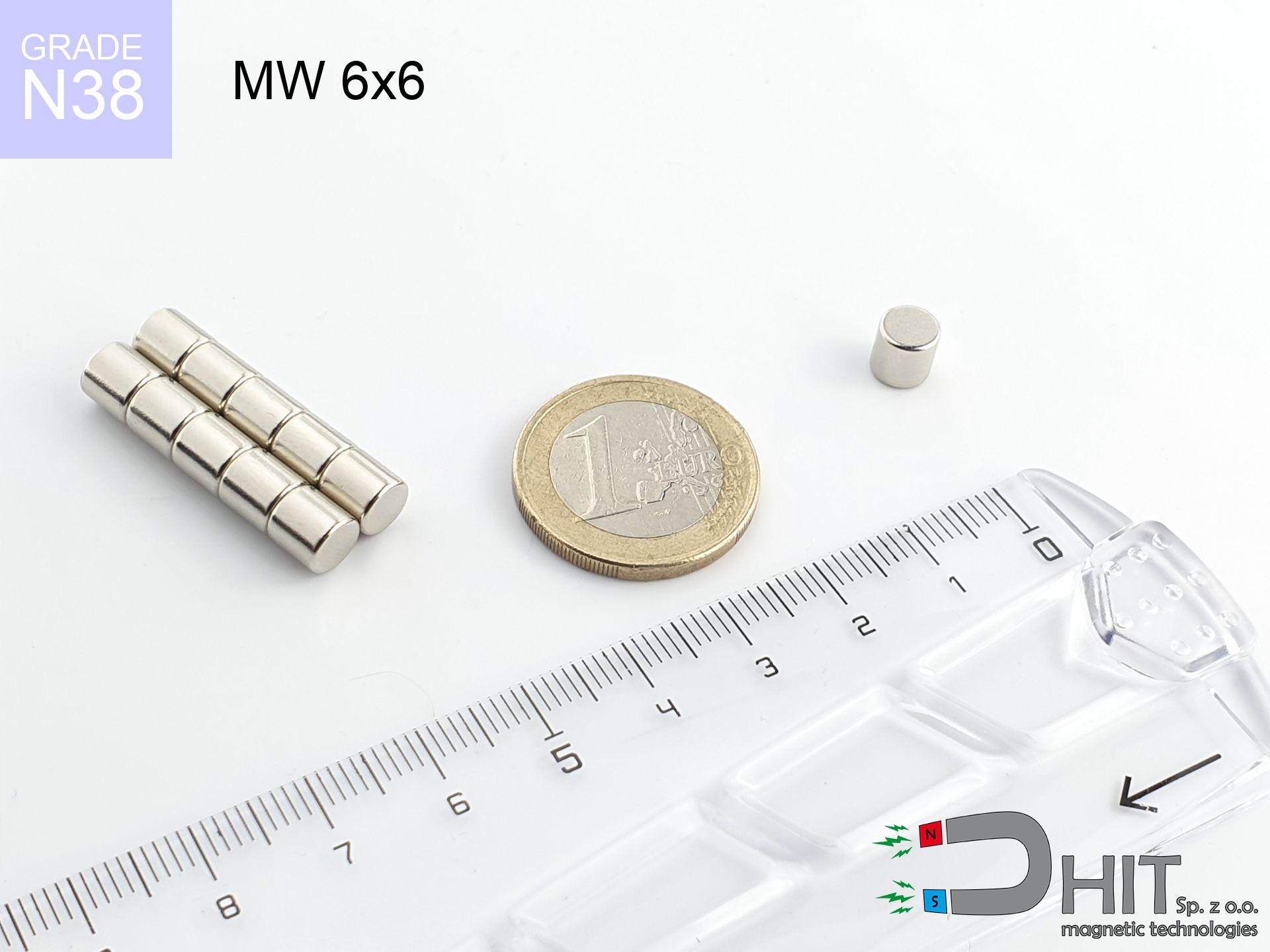MP 40x10.4/5.5x5 / N38 - ring magnet
ring magnet
Catalog no 030249
GTIN: 5906301812258
Diameter [±0,1 mm]
40 mm
internal diameter Ø [±0,1 mm]
10.4/5.5 mm
Height [±0,1 mm]
5 mm
Weight
37.76 g
Magnetization Direction
↑ axial
Load capacity
2.27 kg / 22.26 N
Magnetic Induction
391.66 mT
Coating
[NiCuNi] nickel
27.00 ZŁ with VAT / pcs + price for transport
21.95 ZŁ net + 23% VAT / pcs
bulk discounts:
Need more?Hunting for a discount?
Call us
+48 888 99 98 98
if you prefer send us a note using
contact form
the contact page.
Specifications and appearance of a neodymium magnet can be analyzed on our
modular calculator.
Same-day shipping for orders placed before 14:00.
Magnetic properties of material N38
Physical properties of sintered neodymium magnets Nd2Fe14B at 20°C
Shopping tips
Pros and cons of NdFeB magnets.
Besides their tremendous magnetic power, neodymium magnets offer the following advantages:
- They have stable power, and over nearly 10 years their performance decreases symbolically – ~1% (in testing),
- They have excellent resistance to magnetism drop when exposed to opposing magnetic fields,
- Thanks to the shimmering finish, the surface of Ni-Cu-Ni, gold, or silver-plated gives an clean appearance,
- Neodymium magnets achieve maximum magnetic induction on a their surface, which increases force concentration,
- Due to their durability and thermal resistance, neodymium magnets are capable of operate (depending on the form) even at high temperatures reaching 230°C or more...
- Thanks to flexibility in shaping and the ability to customize to individual projects,
- Huge importance in modern technologies – they find application in data components, brushless drives, precision medical tools, also modern systems.
- Relatively small size with high pulling force – neodymium magnets offer impressive pulling force in small dimensions, which enables their usage in miniature devices
Characteristics of disadvantages of neodymium magnets and proposals for their use:
- At strong impacts they can break, therefore we recommend placing them in steel cases. A metal housing provides additional protection against damage and increases the magnet's durability.
- We warn that neodymium magnets can lose their power at high temperatures. To prevent this, we advise our specialized [AH] magnets, which work effectively even at 230°C.
- They oxidize in a humid environment. For use outdoors we advise using waterproof magnets e.g. in rubber, plastic
- Due to limitations in realizing threads and complex forms in magnets, we propose using a housing - magnetic mount.
- Potential hazard to health – tiny shards of magnets pose a threat, if swallowed, which gains importance in the context of child safety. Additionally, small components of these products are able to be problematic in diagnostics medical when they are in the body.
- High unit price – neodymium magnets cost more than other types of magnets (e.g. ferrite), which increases costs of application in large quantities
Highest magnetic holding force – what contributes to it?
Information about lifting capacity was determined for optimal configuration, including:
- on a block made of structural steel, perfectly concentrating the magnetic field
- possessing a thickness of minimum 10 mm to avoid saturation
- with an polished contact surface
- under conditions of gap-free contact (surface-to-surface)
- for force acting at a right angle (pull-off, not shear)
- at ambient temperature room level
Determinants of practical lifting force of a magnet
In real-world applications, the real power is determined by several key aspects, ranked from crucial:
- Gap (between the magnet and the plate), since even a microscopic clearance (e.g. 0.5 mm) leads to a drastic drop in lifting capacity by up to 50% (this also applies to varnish, rust or dirt).
- Load vector – maximum parameter is obtained only during perpendicular pulling. The shear force of the magnet along the plate is usually many times smaller (approx. 1/5 of the lifting capacity).
- Metal thickness – the thinner the sheet, the weaker the hold. Part of the magnetic field penetrates through instead of generating force.
- Material composition – different alloys reacts the same. Alloy additives worsen the interaction with the magnet.
- Plate texture – ground elements guarantee perfect abutment, which increases field saturation. Uneven metal reduce efficiency.
- Thermal factor – high temperature weakens magnetic field. Exceeding the limit temperature can permanently damage the magnet.
* Holding force was tested on the plate surface of 20 mm thickness, when a perpendicular force was applied, in contrast under attempts to slide the magnet the lifting capacity is smaller. Moreover, even a slight gap {between} the magnet’s surface and the plate decreases the lifting capacity.
Safe handling of neodymium magnets
This is not a toy
Always keep magnets away from children. Ingestion danger is high, and the consequences of magnets connecting inside the body are life-threatening.
Phone sensors
Note: neodymium magnets produce a field that interferes with precision electronics. Keep a separation from your mobile, tablet, and GPS.
Threat to electronics
Intense magnetic fields can corrupt files on payment cards, HDDs, and other magnetic media. Keep a distance of min. 10 cm.
Medical interference
Patients with a ICD have to keep an large gap from magnets. The magnetism can disrupt the operation of the implant.
Pinching danger
Large magnets can break fingers in a fraction of a second. Under no circumstances place your hand betwixt two attracting surfaces.
Caution required
Exercise caution. Neodymium magnets act from a distance and snap with huge force, often faster than you can react.
Demagnetization risk
Keep cool. NdFeB magnets are susceptible to heat. If you require resistance above 80°C, ask us about special high-temperature series (H, SH, UH).
Allergic reactions
Certain individuals experience a sensitization to nickel, which is the typical protective layer for NdFeB magnets. Frequent touching can result in an allergic reaction. We recommend use safety gloves.
Dust is flammable
Fire hazard: Rare earth powder is explosive. Do not process magnets without safety gear as this risks ignition.
Shattering risk
NdFeB magnets are ceramic materials, meaning they are prone to chipping. Collision of two magnets leads to them cracking into small pieces.
Warning!
Need more info? Read our article: Are neodymium magnets dangerous?




![UMGZ 42x20x9 [M8] GZ / N38 - magnetic holder external thread UMGZ 42x20x9 [M8] GZ / N38 - magnetic holder external thread](https://cdn3.dhit.pl/graphics/products/um-42x20x9-m8-gz-fof.jpg)


![HH 16x5.3 [M3] / N38 - through hole magnetic holder HH 16x5.3 [M3] / N38 - through hole magnetic holder](https://cdn3.dhit.pl/graphics/products/hh-16x5.3-m3-sud.jpg)

